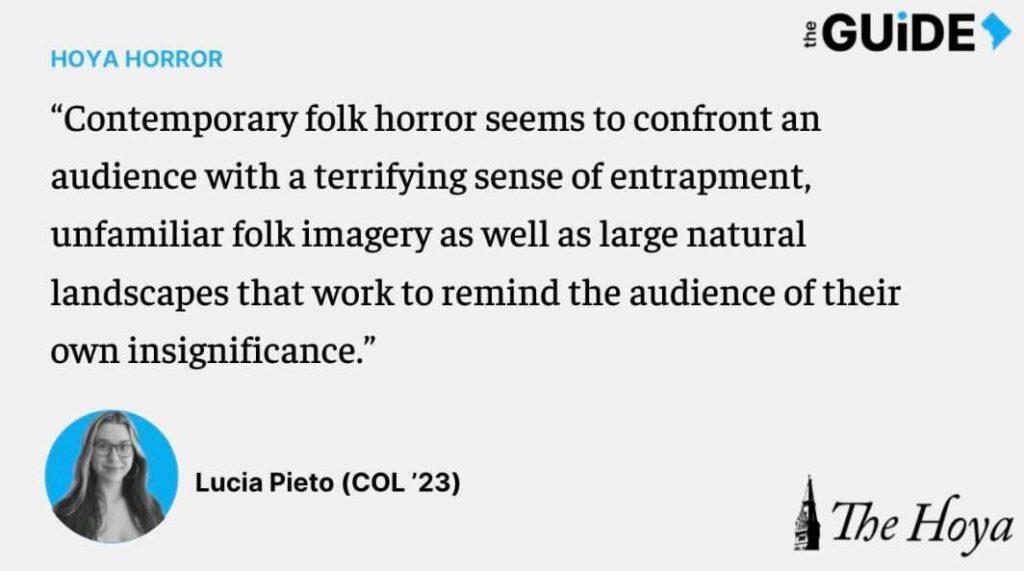Isolation, nature and murder: welcome to folk horror.
Haunting natural landscapes and the cultish terror of folk horror have been a mainstay of the horror genre for decades, but the subgenre has experienced a resurgence in the past decade with Robert Eggers’ “The Witch” in 2015 and Ari Aster’s “Midsommar” in 2019.
With films like “Lamb” and “The Feast,” both released in 2021, this trend does not seem to have tapered out. Having noticed this recent revival of folk horror, I was eager to look into the subgenre to explore where it came from and why it has reemerged into today’s mainstream horror scene.
One of the earliest folk horror films was the 1922 Swedish silent film, “Häxan,” which blended a documentary style narrative with dramatic storytelling that profiled the practice of witchcraft from the middle ages into the early 20th century.
Other films like “Onibaba,” released in Japan in 1964, had an important influence on the subgenre by using folklore in modern horror. However, the start of Folk horror as it exists in films today mainly began in late 1960s and early 1970s British film.
Three films in particular are credited with solidifying the start of the subgenre: the 1968 film “Witchfinder General,” the 1971 film “The Blood on Satan’s Claw” and the 1973 film “The Wickerman.”
Though all similar in tone, these three films have very little in common in terms of story. Rather, they are bound together by their emphasis on rural landscapes and isolated groups of people — out of which comes violence and horror.
The recent comeback of this subgenre begs the question: why have we seen a folk horror revival in the mid-2010s and early 2020s? While modern folk horror has a lot in common with folk horror from the 60s and 70s, I would argue contemporary folk horror focuses on different elements of the genre to scare, like isolation, alienation and a lack of belonging.
It is largely theorized that folk horror from the late 60s and 70s used the supernatural notions from the counterculture new age movement in Europe as an inspiration for its scares, a noticeable difference from today’s folk horror flicks.
The prominence of rural isolation also began to become a defining characteristic of the subgenre during early folk horror titles. Aside from the obvious blending of folklore with horror to scare audiences, folk horror movies are usually set amongst desolate farmland with a lot of the cinematography showcasing this landscape.
The point of these shots is not just to showcase the grandness of the natural world, but also to show how the same features can simultaneously trap the characters from escape.
In folk horror films, nature is not just beautiful — it is a threatening reminder of how much power it can have over the characters.
The remote settings of films show how characters are guarded from civilization, leading them to exhibit skewed morals and social practices, having been on their own for elongated periods of time. As a result, in the case of folk horror, violence and death always occur.
Additionally, while modern folk horror shares a lot of traits with early folk horror, it seems to focus on exploiting the audience’s fear of isolation and sense of belonging to a much greater extent.
Take the ending of “Midsommar” as an example, in which the main character, Dani, finds peace after witnessing the death of her family by joining a murderous cult. Her bizarre happiness in joining the murderous cult may be attributed to relief at being cut off from the increasing solidarity and technology-dependent nature of daily life, something that has been at an all-time high due to the pandemic.
Contemporary folk horror seems to confront an audience with a terrifying sense of entrapment, unfamiliar folk imagery as well as large natural landscapes that work to remind the audience of their own insignificance.
Our current, more isolated social situations then seem to have made the revival of folk horror much more impactful.
Considering that a defining feature of folk horror is its emphasis on seclusion, the current state of the world these past two years has allowed folk horror to provide a completely new layer of anxiety that does not appear to be escaping us any time soon.
Lucia Pieto is a junior in the College. Hoya Horror appears in print and online every other week.














